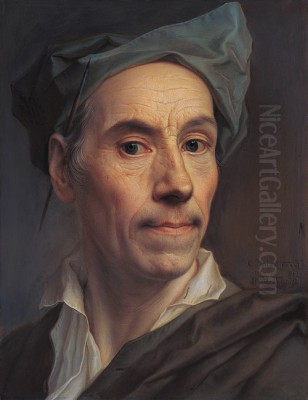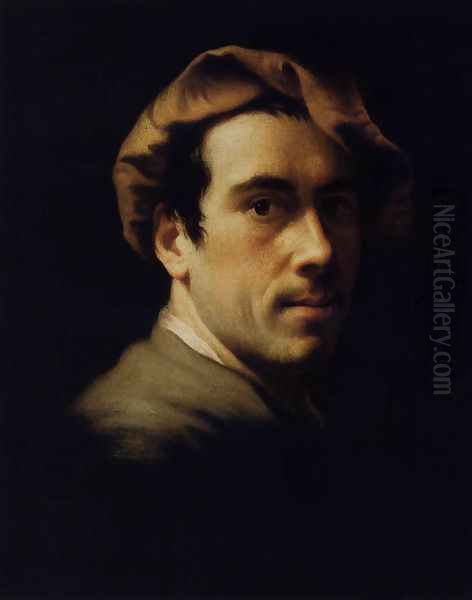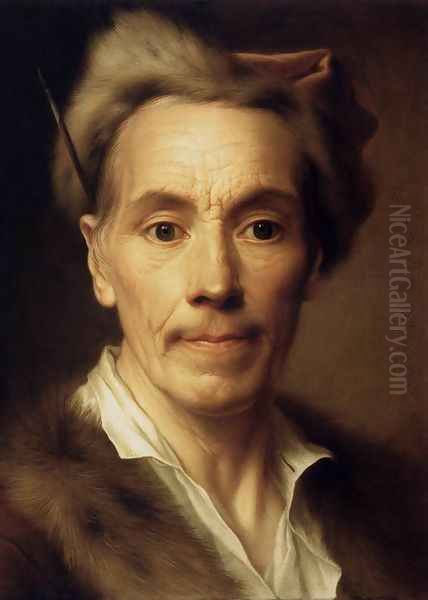
Christian Seybold stands as a significant, if sometimes overlooked, figure in the landscape of 18th-century German and Austrian art. Active during the High Baroque period, Seybold carved a distinct niche for himself as a painter of portraits, renowned for his meticulous detail, striking realism, and insightful character studies. Born in the German city of Mayence (Mainz), he would later find considerable success in Vienna, eventually attaining the prestigious position of court painter to Empress Maria Theresa. His work, while rooted in the traditions of Baroque realism, also displays a unique sensibility that continues to intrigue art historians and enthusiasts alike.
Early Life and Artistic Formation
Christian Seybold was born in Mayence, likely in 1697, though some sources suggest 1695. The exact details of his early training remain somewhat obscure, a common challenge when researching artists from this period who were not part of the major Italian or French academies from their inception. However, it is widely accepted that his artistic development was profoundly shaped by the prevailing trends in German and Dutch painting.
One of the most significant influences on Seybold's style was the work of Balthasar Denner (1685-1749). Denner, a Hamburg-born painter also active in various German courts and in Holland and England, was celebrated for his almost hyper-realistic portraits. He specialized in depicting elderly subjects, rendering every wrinkle, hair, and textural detail of skin and fabric with astonishing precision. Seybold clearly absorbed Denner's commitment to verisimilitude, adopting a similar painstaking approach to capturing the physical likeness of his sitters. This meticulousness became a hallmark of Seybold's own output.

Another important figure in Seybold's artistic milieu, particularly during his formative years or early career, was Jan Kupecký (1667-1740). A Bohemian painter of considerable renown, Kupecký worked in Hungary, Italy, and notably Vienna, where Seybold would later establish himself. Kupecký's style, itself influenced by the dramatic lighting of Caravaggio and the psychological depth of Rembrandt van Rijn, offered a model of expressive portraiture that went beyond mere surface likeness. It is through artists like Kupecký, and through direct study of available works, that the pervasive influence of Rembrandt likely reached Seybold. Rembrandt's mastery of chiaroscuro, his empathetic portrayal of human emotion, and his innovative "tronies" (character studies or head-and-shoulders portraits not intended as formal commissions) resonated deeply within the Northern European artistic consciousness.
Seybold's early works suggest a period of absorbing these influences, experimenting with technique, and honing his observational skills. The artistic environment of the German-speaking lands, while perhaps not as dominant as Paris or Rome at the time, was nonetheless vibrant, with a strong tradition of craftsmanship and a demand for portraiture from aristocratic and bourgeois patrons.
The Distinctive Style of Christian Seybold
Christian Seybold's mature style is characterized by an intense, almost startling realism. He possessed an extraordinary ability to render textures – the softness of velvet, the sheen of silk, the roughness of aged skin, the glint of an eye – with a precision that could rival photography, had it existed. This dedication to detail was particularly evident in his "tronies," a genre he excelled in. These works, often depicting elderly men or characterful individuals, were not necessarily commissioned portraits of specific people but rather studies of expression, age, and human typology. In these, Seybold could give free rein to his fascination with the minute particulars of the human face, exploring the landscape of wrinkles, beards, and blemishes with an unflinching gaze.
While the influence of Balthasar Denner is undeniable, particularly in the almost microscopic attention to surface detail, Seybold developed his own distinct artistic voice. Some art historians have noted that Seybold's touch could be perceived as somewhat "harder" or more "artificial" than Denner's, with colors that were less softly blended. However, this was often coupled with a compositional clarity and a precision in drawing that gave his figures a strong, almost sculptural presence. His figures are typically presented against dark, neutral backgrounds, a common Baroque convention that served to throw the illuminated face and upper body into sharp relief, concentrating the viewer's attention on the sitter.

His palette, while capable of richness, often favored earthy tones and a careful modulation of light and shadow to model form. Unlike the more flamboyant brushwork of some of his Italian or Flemish contemporaries like Giovanni Battista Tiepolo or the followers of Peter Paul Rubens, Seybold's brushwork is generally tight and controlled, subservient to the goal of achieving a smooth, highly finished surface. This meticulous finish contributed to the sense of heightened reality in his paintings.
Masterpieces and Notable Works
Christian Seybold's oeuvre consists primarily of portraits, including a number of insightful self-portraits that track his appearance and perhaps his evolving self-perception over time. Among his most celebrated works is a "Self-Portrait as a Young Man," often dated to around the 1720s or 1730s. In this painting, he presents himself with a direct, confident gaze, his features rendered with the characteristic clarity and precision that would define his career. The work demonstrates his early mastery of capturing not just physical likeness but also a sense of the sitter's personality.
Perhaps even more famous is his "Self-Portrait as an Old Man," likely painted in the later stages of his career, possibly around the 1760s. (Note: some older sources incorrectly date a work titled "Self-Portrait: Old Man" to 1660, which is impossible given Seybold's birth date; this likely refers to a misattribution or a different work). In his late self-portraits, Seybold confronts the themes of aging and mortality with an unflinching honesty that echoes Rembrandt's own late self-examinations. The detailed depiction of wrinkled skin, graying hair, and the weariness of age is rendered without sentimentality, showcasing his technical virtuosity while also offering a poignant meditation on the human condition. These works are powerful examples of the "tronie" tradition, elevated by the personal dimension of self-representation.
Many of Seybold's other works feature anonymous sitters, often elderly men with expressive faces, which allowed him to explore the nuances of character and the effects of time. These "character heads" were popular and demonstrated his skill in a manner that was perhaps less constrained by the formal requirements of commissioned portraiture. His subjects are often depicted in half-length or bust-length format, focusing intensely on the face.
Seybold's paintings are now housed in prestigious collections across Europe, including the Uffizi Gallery in Florence, the Hermitage Museum in St. Petersburg, and the Kunsthistorisches Museum in Vienna. The presence of his works in such esteemed institutions attests to the recognition of his skill and his contribution to Baroque art. Each piece showcases his remarkable ability to create a tangible sense of presence, making his sitters feel almost alive before the viewer.
A Career in Vienna: Court Painter to Empress Maria Theresa
The move to Vienna marked a significant turning point in Christian Seybold's career. During the 18th century, Vienna was a major European capital, the heart of the Habsburg Empire, and a vibrant center for the arts. The Imperial court, as well as the wealthy aristocracy, provided ample patronage for painters, musicians, and architects. Seybold's arrival in Vienna, likely by the 1740s, placed him in this stimulating environment.
His talent for detailed and lifelike portraiture did not go unnoticed. In 1749, Christian Seybold achieved a pinnacle of professional recognition when he was appointed court painter (Kammermaler) to Empress Maria Theresa. Maria Theresa, one of the most formidable rulers of the 18th century, was also a significant patron of the arts, understanding its importance in projecting imperial power and cultural sophistication. Holding the position of court painter was not only a mark of high honor but also provided a degree of financial security and access to influential circles.
As court painter, Seybold would have been tasked with producing portraits of the Empress, her family, and other members of the court. These official portraits would have required a blend of his characteristic realism with the decorum and idealization often expected in royal portraiture. While he continued to produce his more personal "tronies," his role at court solidified his reputation and placed him among the leading painters in Vienna at the time. His meticulous style would have appealed to patrons who valued verisimilitude and a clear depiction of status and character.
Seybold in the Context of European Baroque Painting
To fully appreciate Christian Seybold's contribution, it is essential to view him within the broader context of European Baroque painting. The Baroque era, spanning roughly from the early 17th to the mid-18th century, was characterized by dynamism, emotional intensity, and often, a profound realism.
In Italy, the legacy of Caravaggio (1571-1610) continued to influence painters with his dramatic use of light and shadow (tenebrism) and his unidealized depiction of figures. While Seybold's style was less overtly dramatic, the commitment to realism has distant echoes of Caravaggio's impact. Later Italian portraitists like Rosalba Carriera (1673-1757), famous for her pastel portraits, offered a softer, more Rococo sensibility that contrasted with Seybold's more robust realism.
In the Netherlands, the Golden Age of Dutch painting in the 17th century had produced masters like Rembrandt van Rijn (1606-1669), Frans Hals (c. 1582-1666), and Johannes Vermeer (1632-1675). Rembrandt's psychological depth and mastery of light, Hals's lively brushwork and capture of fleeting expressions, and Vermeer's tranquil interior scenes and subtle light effects all contributed to a rich tradition of realism and genre painting. Seybold's "tronies" are direct descendants of the character studies popularized by Rembrandt and his circle.
Flemish Baroque, dominated by Peter Paul Rubens (1577-1640) and his pupil Anthony van Dyck (1599-1641), showcased a more flamboyant and often aristocratic style. Van Dyck, in particular, became the archetypal court portraitist, influencing generations of painters across Europe with his elegant and flattering depictions of royalty and nobility. While Seybold's style was less grand than Van Dyck's, the function of court portraiture shared common goals.
In France, the Baroque evolved into the grandeur of the Louis XIV style, with portraitists like Hyacinthe Rigaud (1659-1743) and Nicolas de Largillière (1656-1746) creating imposing state portraits that emphasized power and opulence. Later, the lighter, more intimate Rococo style would emerge with artists like Jean-Antoine Watteau (1684-1721) and François Boucher (1703-1770).
Within the German-speaking lands and Central Europe, Seybold was part of a strong tradition of portraiture. Besides Balthasar Denner and Jan Kupecký, other notable contemporaries or near-contemporaries included Georg Desmarées (1697-1776), a Swedish-born painter active in Germany, and Antoine Pesne (1683-1757), a French painter who became court painter to Frederick the Great in Prussia. These artists, each with their own stylistic nuances, contributed to the diverse artistic fabric of the region. Seybold's particular brand of intense, detailed realism set him apart, offering a more Northern European, almost Netherlandish sensibility within the Viennese court. His work can be seen as a continuation of the meticulous realism found in earlier German masters like Albrecht Dürer or Hans Holbein the Younger, albeit filtered through the lens of Baroque aesthetics.
Critical Reception and Artistic Legacy
During his lifetime, Christian Seybold enjoyed considerable acclaim, particularly in Vienna. His appointment as court painter is a testament to the high regard in which his skills were held. His ability to capture a precise likeness, combined with his painstaking technique, appealed to patrons who desired faithful and finely wrought representations. The popularity of his "tronies" also suggests an appreciation for his skill in character study and his almost scientific observation of the human physiognomy.
However, like many artists whose style is highly specific, critical opinions have varied over time. Some later critics, particularly those favoring more painterly or emotionally expressive styles, might have found Seybold's meticulousness to be somewhat "pedantic" or his surfaces too "hard." The very qualities that made his work distinctive – the intense detail and smooth finish – could be seen by some as lacking the bravura brushwork or overt emotionalism found in other Baroque masters.
Nevertheless, Seybold's technical mastery is undeniable. His works are often compared to the detailed realism of early Netherlandish painters like Jan van Eyck, albeit on a different scale and with different thematic concerns. In an era that was beginning to transition towards the lighter Rococo and then the more austere Neoclassicism, Seybold's commitment to a highly detailed Baroque realism remained steadfast.
His legacy lies in his contribution to the tradition of realistic portraiture in Central Europe. He demonstrated that meticulous detail and profound character insight could coexist. His self-portraits, in particular, remain compelling examples of self-examination through art. While he may not have founded a major school or had a vast number of direct followers who emulated his exact style, his work stands as a distinctive example of a particular approach to portraiture within the broader Baroque movement. His paintings continue to be studied for their technical brilliance and their quiet, intense observation of humanity.
Conclusion
Christian Seybold was a painter of remarkable skill and singular vision. From his origins in Mayence to his successful career in Vienna as a court painter, he remained dedicated to a form of meticulous realism that captured both the external likeness and the internal character of his subjects. Influenced by masters of detail like Balthasar Denner and the profound humanism of the Rembrandt tradition, Seybold forged a style that was uniquely his own. His "tronies" and self-portraits, in particular, stand out as powerful explorations of human physiognomy and the passage of time.
In the grand tapestry of European Baroque art, Christian Seybold occupies a specific and important place. He represents a strand of German and Austrian painting that valued precision, craftsmanship, and insightful observation. His works, preserved in major museums, continue to engage viewers with their almost tangible reality and the quiet intensity of the personalities they depict, securing his position as a notable master of Baroque portraiture.